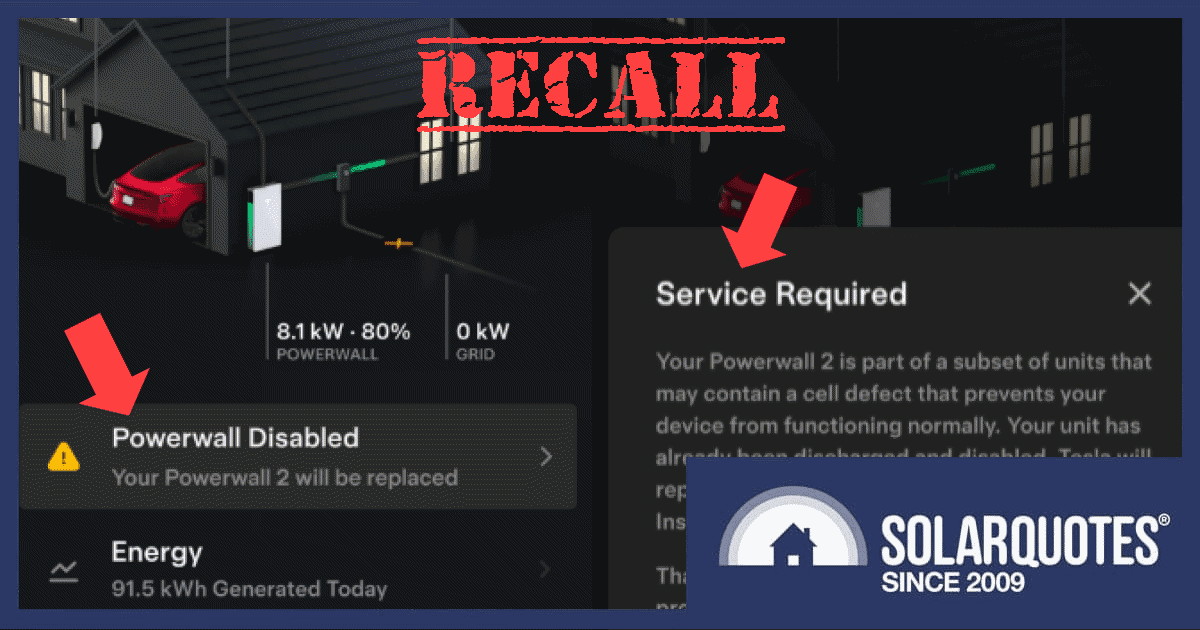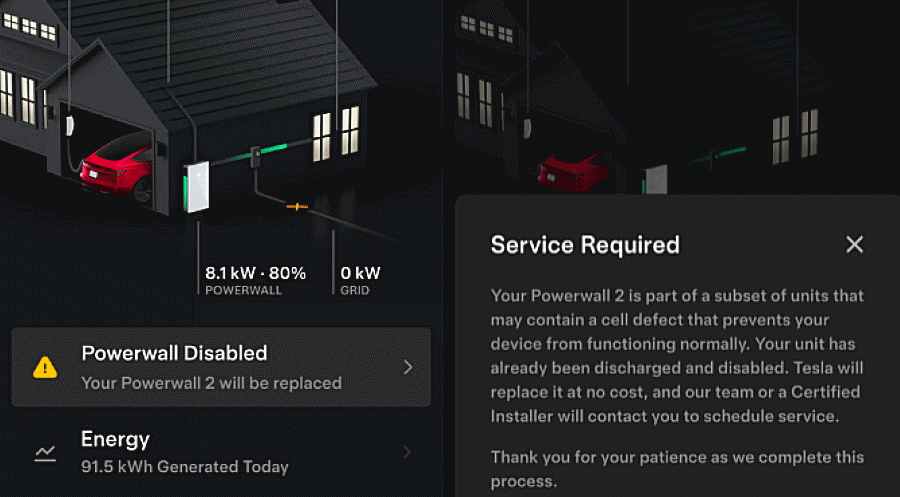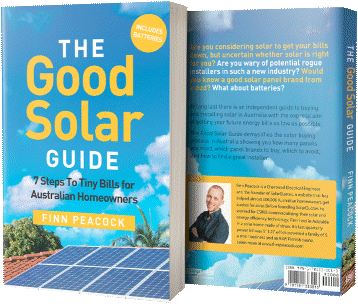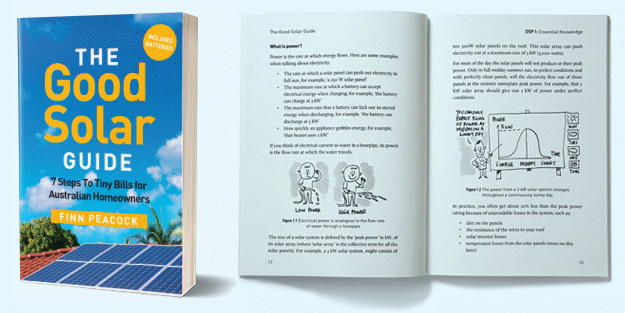
Certain Tesla Powerwall 2 batteries installed in Australia are subject to a recall after reports of battery cells in some systems smoking or venting flame.
What Happened And What’s The Risk?
On Tuesday, 16 September 2025, the Australian Competition and Consumer Commission (ACCC) published a voluntary recall notice concerning Powerwall 2 batteries on the ACCC’s ProductSafety website.
The notice states in part:
“Tesla has identified certain lithium-ion battery cells from a third-party supplier in a subset of Powerwall 2 systems that may fail and overheat. Tesla has received reports of Powerwall 2 units with the affected battery cells smoking or emitting flames, resulting in minor property damage.”
The mention of smoke and flames pretty much says it all — the risk of a fire (and fumes) potentially causing property damage, injury or death. While ‘a few’ incidents have occurred where there has been damage to property (details of which haven’t been disclosed), there have been no reports of injuries as yet.
What’s Tesla Doing?
Most affected units have already been remotely discharged and disabled by Tesla, but the company advises owners to check for a message in the Tesla app, their emails or voicemails.
The messages in the app looks like so:
It says:
“Your Powerwall 2 is part of a subset of units that may contain a cell defect that prevents your device from functioning normally. Your unit has already been discharged and disabled. Tesla will replace it at no cost, and our team or a Certified Installer will contact you to schedule service. Thank you for your patience as we complete this process.”
Whether new owners will be provided the same model or a Powerwall 3 isn’t clear. Tesla stopped taking orders for the 2 in late 2024/early 2025 and it is no longer Clean Energy Council approved as it did not comply with an updated battery standard; but this may not be issue given it’s a warranty situation replacing like-for-like.
The approximate timeframe for replacements isn’t indicated. As for compensation for downtime; that will be considered on a case-by-case basis. The timing isn’t great (but it never is for recalls), with some installers working with Powerwall already under the pump from demand triggered by the Cheaper Home Batteries program.
The primary contact should be the original installer. But if that installer is unavailable, Tesla can be contacted by calling 1800 958 369 between 8:00 am and 6:00 pm AEST, or emailing [email protected].
Further recall information is available on the Tesla website.
How Many Powerwall 2 Batteries Are Affected?
Neither the ACCC or Tesla have provided any numbers that I know of. – 30 June 2022, but that doesn’t mean all sold during that timeframe are impacted.
Tesla appears to be making the right moves with the recall process at this point. The situation shouldn’t turn out to be an excruciatingly drawn-out affair such as that with the LG battery recall that started in late 2020 and is *still* playing out. But the Clean Energy Council advises if there are issues resolving a battery replacement, consumers can submit a complaint with the CEC.
A Very Brief History Of Powerwall
Powerwall 2 has been popular in Australia; as has its successor, Powerwall 3. But the company’s share of the local home battery market has reportedly shrunk in the face of increasing competition and as a result of some of the antics of Tesla CEO Elon Musk.
The original Tesla Powerwall was unveiled by Elon Musk in 2015 and the world’s first installation was in Australia in January 2016; marking the start of the home battery revolution. The original model was soon followed by Powerwall 2, which entered mass production in 2017. The 3 was released in 2023, but wasn’t available for purchase and installation in Australia until August 2024.
More than one million Powerwall batteries have been installed globally. This is the first recall in Australia I’m aware of; although the 2’s CEC certification for Australia temporarily expired in 2022 after what was reportedly an admin faux pas.


 RSS - Posts
RSS - Posts



Hopefully people will be given the option of going to the newer battery that meets current standards, perhaps that might require a cash adjustment, but if it is more than a few batteries i doubt they will have the “new old stock” laying about given they can’t sell them here anymore.
I loathe Mr Musk, and wouldn’t touch a Tesla product with a barge pole as a result, I would not put my money in his pocket.
But I have to give them credit for doing the right thing and having a voluntary recall.
Tesla communications could have been better, I saw a lot of PW2 owners who were completely caught off guard and not in the know by their batteries being bricked for weekss
Keeping the customer in the dark is classic Tesla modus operandi.
For a while the Tesla PW 2 kit included a green coloured Phoenix brand connector for the battery AC harness connection. The connector on my battery overheated and was a melted mass of plastic when my installer inspected it. He commented that the overheating of this connector was a known issue and newer units were supplied with Waco connectors for this reason. No official notification from Tesla regarding an issue with potential to start a battery fire.
Thank you for the alert.
The Netzero app, once connected to the Tesla Gateway, is able to display the date and factory of manufacture for Powerwall. This may provide some guide to whether a particular Powerwall may be affected.
However it would be useful if Tesla provided a range for date of manufacture rather than date sold.
Netzero also has some interesting analysis on Powerwall 2 capacity issues based on manufacture date and part number – showing 2019 was also not a good year. Mine is one of those affected and currently waiting on a warranty replacement.
https://www.netzero.energy/content/2025-02/powerwall-analysis
What a nightmare for those affected by this recall. Replacement PW 2s would be thin on the ground and installers are flat tack installing new batteries. An even bigger nightmare for ppl like myself with microinverters on the roof…..a PW 3 is not the most efficient battery to be using in an AC coupled set up.
Can you apply for a refund instead? Use the money to install a more reliable and open system.
Tesla warranty doesn’t include a refund as far as I know. They warranty to replace any defective hardware with a new or second hand equivalent.
It is written in the warranty that they can pay if the Powerwall 2 fails during the warranty period. It would be pro rata (no doubt) so you’d likely lose out.
“A refund should be the full amount the consumer paid for the product. The business must not deduct an amount from a refund to take into account the use a consumer has had of the product.”
But Tesla have already shipped the replacements to installers. (MC Electrical say they have received most of them for their customers)
It will be how quickly your installer can fit you in to their already busy schedule.
Thankfully most batteries now being made and installed are LFP . . . but who knows just how things will be in 5 or 10 years time as these batteries lose some performance / degrade.
This sort of recall from a high end company like Tesla does cause me concern about my plan to get (2) SolarEdge batteries to keep my system totally compatible with both internal system and third party systems like Amber and other possible VPPs.
They are the same NMC chemistry.
Les, apropos your degradation concern, LFP batteries tend to have double the cycle life of NMC, despite being cheaper to make. They’re also much less SoC sensitive, contain no flammable electrolyte, and have a significantly higher thermal runaway threshold. (Mine are warranted for 6,000 cycles to 80% SoH, while the newer model is 8,000 cycles to 60% SoH – I think that’s the same.)
Given a number of LFP battery brands, I’m at a loss to comprehend why NMC would be considered for stationary applications. OK, the massive LG chem immolation problems could be ascribed to product chemistry issues, but Tesla’s repetition, and the fires in Boeing Dreamliner batteries a few years ago, evidence the NMC chemistry’s low thermal runaway threshold.
I’m impressed that the flames appear to have been contained. Compared to petrol fires, as in the ICE car which burned a few days ago (on the news), even NMC seems safer. But it’s a bother, not needed in a busy life. I’m off-grid, so it’d be a blackout.
Yes Erik, there aren’t many with NMC chem used now, the new (or soon available) SolarEdge stackable is LFP too, so might inquire about these, see if compatible, and wait if so.
They might well be cheaper for 20kwh or so.
I have received a couple of quotes for the current NMC, and got some quotes on different LFP stackable, but there are issues with working seamlessly, or needing a 3rd inverter on our third phase to oversee grid ops . . . the 2 inverters now working great with optimisers, so don’t want to disturb that.
Yes, as LFP is cheaper to make, they’re invariably cheaper to buy as individual cells – not least the 5.5 kg 314 Ah cells I’m using.
Compatibility with an earlier purchase can be problematic, except where stackable modules incorporate a DC-DC converter for voltage matching. (E.g. Sigenstor?) Thus the LFP doubtless won’t be able to be just plonked directly in parallel with existing NMC. Another inverter on the 3rd phase sounds nicely flexible, if the loads can be organised.
I’d ask SolarEdge for their upgrade strategy. (It may just be to continue offering NMC to old customers.) I’d put that on an outer brick wall, with cementsheet soffit and metal fascia & guttering above. A hood-like metal sunshade would be comforting too. (Even if it’s not LG Chem or Tesla. 😉
I agree with most of the things you said about LFP but you’re wrong about them not having a flammable electrolyte – it’s just less flammable. They also have a higher ignition point when compared to NMC and NCA because the cathode has to get significantly hotter to release it’s oxygen content.
John, that is awfully deep desperation to run the “you’re wrong” flag up the pole, out of context. Good LFP batteries are’nt found to self-combust, but require external ignition for the external fire to burn the electrolyte, for heaven’s sake! Here’s one of many non-ignition demonstrations: https://www.youtube.com/watch?v=D8xNjz73p80&t=254s
So LFP may not withstand a housefire if you light it, but it doesn’t much start it, experience shows. But don’t breathe the fumes – that’s not safe.
Incidentally, your oxygen-release claim does appear to be fatally questionable. Multiple sources confirm that they “do not produce oxygen during thermal runaway”. We’re also only talking “hot fuming point”, as there is no self-ignition in observed reality – do you agree?
I know of only one LFP house battery emitting clouds of smoke, in USA. Again there were no flames. The resulting wall smudges wiped off the paint with a wet rag. Small NMC bike batteries burn down houses almost every week now.
This could be considered a “Major Failure” under Consumer Law – even more so if it cannot be resolved in a reasonable timeframe.
If it’s Major Failure then the consumer decides Refund or Replacement (go the refund and claim the rebate on a new install).
Tesla don’t comply with Australian Consumer Law- a number of people have been fighting to get their Powerwall 2’s replaced that are suffering higher capacity degradation than normal. Tesla refuses to replace them until they hit the 30% capacity degradation before 10 years- as written in the warranty. (Along with the Australian Consumer Law blurb mentioning poor quality etc. But they ignore that section of their own warranty.)
Mine is at 24% degradation at five years old- that definitely hits the definition of poor quality (compared to other owner’s experiences- like Finn recently reported his seven year old Powerwall 2 is at 7% degradation IIRC.)
My PW2 was installed in May 2020 and is currently at 29% degradation. Just waiting for it to tick over to 30%.
FYI
My original PW2 was installed March 2022 but failed with a very loud BANG (a DC fault) 49 days later (possibly one of the faulty batch).
A replacement was installed but only lasted ~12 months with a final capacity of 10.8 kWh.
Another replacement was installed with a capacity of 13.8 kWh but eventually stabilized at 12.8 kWh after Tesla support forced recalibration.
Both PW2 replacement serial numbers began with TAU… (a 2nd hand refurbished PW2, as is allowed under the Tesla AU warranty).
Suggest using “NetZero for Powerwall” to monitor/chart PW capacity over time (requires subscription for diagnostics access) or “Powerwall Companion”.
NetZero for Powerwall, under Monitoring, provides detailed PW diagnostics information, capacity charting by PW serial number (requires subscription).
Powerwall Companion for android (not iPhone) only shows combined capacity for one or multiple PWs.
Powerwall Companion for Windows charts Battery Health for each PW capacity by serial number.
I dread what Tesla will be supplying as “replacements” for the Powerwall 2 as time goes on. There’s a lot of them out there from the bad batch they produced around 2019. You could end up with a lemon replacement from them making up refurbished units filled with the best batteries out of the 2019 units they’ve already removed. If you’re close to 10 years it might only last just beyond that before diving below the 70% again. I’d never buy one of their cars – they thumb their nose at Australian Consumer Law and the customer is left with nobody to force them to comply. They also hold all the cards in this situation, as their app hides the info on the battery capacity. You need to use third party app- that a lot of owners don’t know about. Tesla have also been making it increasingly hard to get the apps to work. I’ve been locked out of my Gateway 2 (default PW doesn’t work) and you can no longer reset the password yourself.
I just received a “Powerwall Disabled” notice on the Tesla Powerwall app for the currently installed PW2, the 2nd Powerwall2 replacement (as above, previous entry), serial number starting with TAU.., indicating a second hand refurbished PW2.
Called the original installer where they indicated this PW2 message indicates it is part of the recall.
Both previous PW2 replacements, Tesla indicated a 4-6 weeks wait. (was >4 weeks)
No indication as yet, as to the current wait time, but suspect the same wait time period applies.
Awaiting a response from Tesla / installer to see how long this takes.
Our 2022 installed Powerwall 2 failed 6 weeks ago, during day-long power outage, with the message: Side Switch Off, Powerwall will not operate (the switch was on). I found it hard to get a response from the solar system installer, but after going through the troubleshooting process in the Tesla app, discovered that the installer Tesla had on record was a subcontractor to our installer. I contacted the subcontractor directly and was told 2 weeks ago that they were waiting for a response from Tesla. A few days ago they told me that Tesla had said it would be another 4 to 6 weeks to get a replacement.
All this is unrelated to the recall, but bad timing to get a replacement.